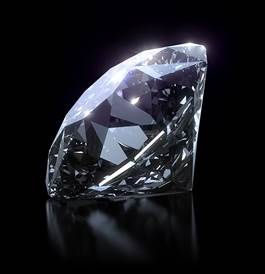Description

Disclaimer: Copyright infringement not intended.
Context
- Union Minister for Commerce and Industry appreciated the Gujarat Government for spearheading several wide-ranging initiatives to promote the Lab Grown Diamonds Sector.
Lab Grown Diamond
- A lab-created diamond is “grown” inside a lab using cutting-edge technology that replicates the natural diamond growing process. The result is a man-made diamond that is chemically, physically, and optically the same as those grown beneath the Earth's surface.
- Lab-made diamonds are developed from a carbon seed placed in a microwave chamber and superheated into a glowing plasma ball. The process creates particles that crystallize into diamonds in weeks.
- This tech-based manufacturing directly cuts down the capital and labor-intensive factors of the mined diamond chain and so lab-grown diamonds cost 30-40 percent cheaper than mined despite being 100 percent diamonds.
Lab Grown vs Natural Diamond
Composition and look
- Lab-grown diamonds are comprised of carbon, the same material natural diamonds are comprised of. These diamonds are chemically and optically identical to natural diamonds, so they offer the same shine, sparkle, and brilliance of a naturally mined diamond.
Price
- Lab-grown diamonds are way more affordable than natural diamonds. Natural diamonds are limited in nature because it takes billions of years to create them, while with lab-grown diamonds there is no cap on supply. There are no extra expenses spent on mining and transportation.
Impact on the environment
- As with the mining of any natural resource, diamond mining has a significant impact on the environment. However, lab created diamonds are inherently and significantly less detrimental to the environment as it takes considerably less energy to grow a diamond in a lab than it does to dig it out of the ground. Lab-grown diamonds are the more sustainable option.
Types of Lab-Grown Diamonds
- There are two types of lab-grown diamonds -- CVD and HPHT. India particularly specializes and leads in the chemical vapour decomposition (CVD) technology that is certified as the purest type of diamonds.
HPHT lab grown diamonds
- The process to create an HPHT diamond (High-Pressure High Temperature) was initially developed in the 1950s for industrial purposes.
- HPHT process can also be used to treat mined diamonds to enhance their overall color and clarity. The process was designed to mimic the pressure and temperatures found within the earth where natural diamond crystals are formed over millions of years.
- The HPHT process manages to recreate this environment but allows a diamond to form in a matter of weeks compared to the roughly 150 million years it took to form the world’s natural diamonds.
CVD diamonds
- A CVD diamond (Chemical Vapour Deposition) is a recently invented technique in which diamonds are grown from a hydrocarbon gas mixture, similar to how diamonds form in interstellar gas clouds. The CVD process was created in the 1980s and is a less costly method of creating diamonds out of the two as it requires much less energy.
- In this, a thin slice of diamond seed is placed in a sealed chamber and heated to around 800 degrees Celsius, and then the chamber is filled with other carbon-rich gases such as methane. The gases are ionized into plasma using microwaves, lasers, and other techniques.
- The ionization breaks down the gases and allows the carbon to merge with the diamond seed, growing the diamond up layer by layer.

Lab-grown Diamonds and India
- The fluorescence of lab-grown markets of India started in the mid-2000s and is growing exponentially in the 2020s.
- Like natural diamonds, India has proved its leadership role in the cutting and polishing of lab-grown diamonds. India’s exports of polished lab-grown diamonds were USD 274 million, USD 473 million, USD 637 million, and 1293 million during 2018-19, 2019-20, 2020-21, and 2020-21 respectively. Annual growth during the same periods were 72%, 35%, and 103%.
- In 2021, India’s LGD market accounted for Rs 2,200 crore, and its contribution to the global lab-grown diamond production stands at 15%.
- Number of Lab Diamond Growers has gone up tremendously in the last 2-3 years due to a recession in the natural diamond industry.
- India’s synthetic diamond exports are estimated to be anywhere around 50-60%.
- Nine out of 10 diamonds in the world are estimated to be polished in Surat. Currently, 25-30 percent of diamond polishing units in Surat service lab-grown diamonds, with 15 percent of units dealing only in the lab-created commodity.
Government support
- One of the incentives that the government had brought in is that it has permitted 100 percent foreign direct investment (FDI) in the sector under the automatic route. Further, according to Budget 2019-20, the GST rate has been reduced from 18 percent to 5 percent.
Wrapping Up
- LGD market is growing exponentially as they are greener and environmentally sustainable. They are also 50-60% cheaper than mined India has the potential to become a global hub of lab-grown diamond production and processing.
- The recent industry update by Gem & Jewellery Export Promotion Council reported that India’s polished lab-grown diamond exports amounted to $1.05 billion from April 2021 to January 2022. It recorded stellar growth of 113 percent and is projected to grow further.
- Industry experts are of a consensus that LGD’s business has the capacity to touch the mark of Rs 40,000 crore in the next five years.
- However, keeping in mind the future potential, there is a need to maintain technological self-reliance in the production of machinery and a leadership position in the production of lab-grown diamonds.
- Given India’s expertise in diamond polishing, it is imperative that India positions itself firmly in the lab-grown diamond sector too since the process of polishing is similar. The projected employment creation could be to the tune of 25 lakh by the year 2025.
https://www.pib.gov.in/PressReleasePage.aspx?PRID=1872807














